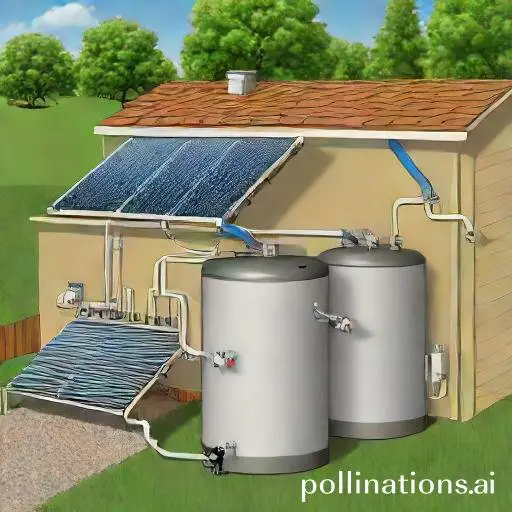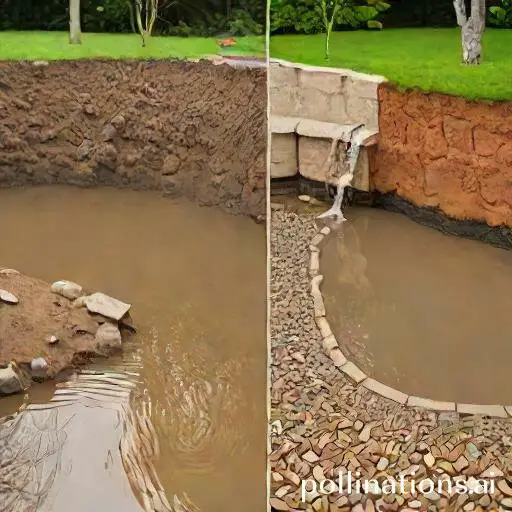
II. Regular maintenance, such as flushing the system and installing a sediment filter, can help prevent sediment buildup.
III. Proper installation and use of the solar water heater can also help reduce sediment accumulation.
Sediment removal is a crucial maintenance task for solar water heaters. Over time, minerals and debris can accumulate in the system, reducing its efficiency and lifespan.
Regular sediment removal helps to optimize the performance of the heater, ensuring maximum heat transfer and energy efficiency. By effectively removing sediment, homeowners can enjoy hot water that is clean and free from impurities.
This not only extends the life of the solar water heater but also improves the overall water quality for everyday use. Keep your solar water heater running smoothly with proper sediment removal.
Causes of Sediment Buildup in Solar Water Heaters
Solar water heaters provide an eco-friendly and cost-effective way to heat water using the sun’s energy. Notwithstanding, over time, sediment buildup can occur within these systems, leading to decreased efficiency and potential damage. Grasping the causes of sediment buildup is crucial for maintaining the optimal performance of your solar water heater.
1. Hard Water
One of the primary causes of sediment buildup in solar water heaters is hard water. Hard water contains high levels of minerals such as calcium and magnesium, which can accumulate within the system over time. As the water heats up, these minerals precipitate and settle, forming sediment in the bottom of the tank and on the heating elements.
To prevent sediment buildup from hard water, consider installing a water softener or using a descaling agent regularly. These treatments help to reduce mineral deposits, ensuring that your solar water heater operates efficiently.
2. Lack of Maintenance
Another common cause of sediment buildup is a lack of regular maintenance. Without proper care, debris, dirt, and other particles can enter the system, leading to sediment accumulation. Vital to schedule routine maintenance for your solar water heater, including flushing the tank and cleaning the heating elements.
During maintenance, ensure that all valves and connections are functioning properly and that any sediment or debris is removed. Regular maintenance not only prevents sediment buildup but also extends the lifespan of your solar water heater.
3. Poor Water Quality
The quality of the water used in your solar water heater can also contribute to sediment buildup. If the water supply has high levels of impurities or contaminants, these substances can settle and form sediment within the system.
Installing a water filtration system or using a sediment filter can help to improve water quality and reduce the risk of sediment buildup. Regularly replacing filters and ensuring that the water source is clean can help maintain the efficiency of your solar water heater.
| Causes of Sediment Buildup | Solutions |
|---|---|
| Hard Water | Install a water softener or use descaling agents regularly |
| Lack of Maintenance | Schedule routine maintenance, flush the tank, and clean heating elements |
| Poor Water Quality | Install a water filtration system and regularly replace filters |
Effects of Sediment Buildup in Solar Water Heaters
Sediment buildup in solar water heaters can have various negative effects on their performance and longevity. Fundamental to understand these effects in order to prevent any potential issues and ensure the efficient operation of your solar water heater.
1. Reduced Efficiency
One of the primary effects of sediment buildup in solar water heaters is reduced efficiency. As sediment accumulates at the bottom of the water tank, it creates a layer that acts as an insulator. This insulating layer prevents the water from being heated effectively by the solar panels, resulting in reduced efficiency in converting sunlight into hot water.
To maintain the optimal efficiency of your solar water heater, it is recommended to regularly flush out the sediment from the tank. This can be done by draining the water and cleaning the tank to remove any accumulated sediment.
2. Increased Energy Costs
Sediment buildup can also lead to increased energy costs. When the solar water heater’s efficiency is compromised due to sediment, it requires more energy to heat the water to the desired temperature. This means that your solar water heater will consume more electricity or gas, depending on the backup heating system, resulting in higher energy bills.
3. Damage to the Solar Water Heater
If sediment buildup is left unaddressed, it can cause damage to the solar water heater. The sediment can corrode the tank and other components, leading to leaks, malfunctions, and even system failure. Additionally, the extra strain on the system caused by sediment can shorten the lifespan of the solar water heater.
To prevent damage and maintain the longevity of your solar water heater, it is crucial to schedule regular maintenance, including flushing out sediment and inspecting the system for any signs of damage or wear.
Methods for Sediment Removal in Solar Water Heaters
Solar water heaters are an eco-friendly and cost-effective way to harness the power of the sun to heat water. In contrast, over time, sediment can build up in the system, reducing its efficiency and potentially causing damage. To ensure optimal performance and prolong the lifespan of your solar water heater, integral to regularly remove sediment from the system. Here are three effective methods for sediment removal:
1. Flushing the System
Flushing the system is a simple and straightforward method to remove sediment from your solar water heater. To do this, you will need to turn off the power supply to the heater and close the inlet and outlet valves. Next, connect a hose to the drain valve and place the other end in a suitable drainage area. Open the drain valve and allow the water to flow out, carrying away the sediment with it. Repeat this process until the water runs clear.
2. Chemical Treatment
Chemical treatment can be an effective way to dissolve and remove stubborn sediment in your solar water heater. There are commercially available chemical descalers specifically designed for this purpose. Follow the instructions provided by the manufacturer for the correct dosage and application method. Pivotal to note that chemical treatments should be used with caution and only as directed to avoid any potential damage to the system.
3. Mechanical Removal
Mechanical removal involves physically removing the sediment from the solar water heater. This method is typically used for larger or more resistant sediment deposits. A professional technician can use specialized tools such as brushes or vacuums to carefully remove the sediment without damaging the system. Essential to hire a qualified technician for this task to ensure the proper handling and maintenance of your solar water heater.
Regular sediment removal is essential for maintaining the efficiency and longevity of your solar water heater. By implementing these methods, you can keep your system running smoothly and enjoy the benefits of clean, hot water powered by the sun.

DIY vs. Professional Sediment Removal
Sediment removal is an important task to maintain the efficiency and longevity of your system. Whether you choose to do it yourself (DIY) or hire a professional, it’s crucial to understand the pros and cons of each approach.
1. Pros and Cons of DIY Sediment Removal
DIY sediment removal can be a cost-effective option for homeowners. It allows you to save money by not hiring a professional service. Notwithstanding, there are some considerations to keep in mind.
- Pros:
- Cost-effective solution
- Flexibility to schedule the task at your convenience
- Opportunity to learn about your system and its maintenance
- Cons:
- Requires time and effort on your part
- Possibility of incomplete removal, leading to recurring issues
- Lack of specialized tools and equipment
2. Benefits of Professional Sediment Removal
Professional sediment removal services offer a range of advantages that can ensure thorough and efficient cleaning of your system.
- Benefits:
- Expertise and experience in sediment removal
- Access to specialized tools and equipment
- Guaranteed removal of all sediments
- Time-saving option for busy homeowners
In terms of sediment removal, the choice between DIY and professional services depends on your priorities and capabilities. If you have the time, knowledge, and resources, DIY can be a viable option. Although, for a thorough and hassle-free experience, hiring a professional sediment removal service is highly recommended.

Preventing Sediment Buildup in Solar Water Heaters
Solar water heaters are a sustainable and cost-effective way to heat water using the power of the sun. Conversely, over time, sediment buildup can occur and reduce the efficiency of your solar water heater. In order to maintain optimal performance, indispensable to take preventative measures to prevent sediment buildup. Here are some effective strategies:
1. Regular Maintenance
Regular maintenance is crucial to prevent sediment buildup in your solar water heater. This involves inspecting the system at least once a year and cleaning any accumulated sediment. It is also important to check for any leaks or damage that may need to be repaired. By regularly maintaining your solar water heater, you can ensure its longevity and efficiency.
2. Water Softening
Hard water contains high levels of minerals such as calcium and magnesium, which can contribute to sediment buildup in your solar water heater. Using a water softener can help reduce the mineral content in the water, preventing sediment buildup. Consider installing a water softening system or using water softening agents to keep your solar water heater free from sediment.
3. Use of Filters
Another effective way to prevent sediment buildup is by using filters in your solar water heater system. These filters can trap any sediment or debris before it enters the system, preventing it from accumulating and causing blockages. Regularly cleaning or replacing the filters will ensure their effectiveness in preventing sediment buildup.
| Preventive Measures | Benefits |
|---|---|
| Regular Maintenance | Ensures longevity and efficiency |
| Water Softening | Reduces mineral content in water |
| Use of Filters | Traps sediment and debris |
Bottom Line
Removing sediment from solar water heaters is crucial for maintaining their efficiency and prolonging their lifespan. Neglecting this task can lead to reduced performance, increased energy consumption, and even system failure. Regular maintenance, including flushing the system and cleaning the tank, can prevent sediment buildup and ensure optimal performance. Additionally, using a water softener or installing a sediment filter can help reduce sediment accumulation in the first place. By taking these steps, homeowners can enjoy the benefits of solar water heating for years to come whilst minimizing the need for costly repairs or replacements.
In summary, sediment removal is an essential aspect of solar water heater maintenance that should not be overlooked. By staying on top of this task and taking preventative measures, homeowners can ensure their systems operate efficiently and effectively, saving money and reducing their environmental impact in the process.
Read More:
1. How To Test Water For Sediment In Water Heaters?
2. Role Of Anode Rods In Preventing Sediment In Water Heaters










